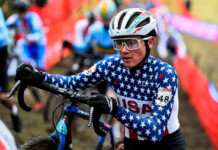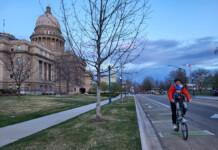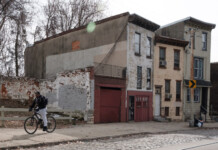By Charles Pekow
As states, both Utah and Idaho leave a lot to be desired when it comes to bicycle friendliness. Both states got low or failing grades in most of the six subjects they were graded on by the League of American Bicyclists (LAB): legislation, policies & programs, infrastructure, education & encouragement, evaluation & planning and enforcement. Both states fell below average in the annual Bicycle Friendly America State rankings. Idaho finished 30th out of 50 states; Utah ranked just below it at 31. They both scored poorly enough to be flunked out of college.
But officials from both states question the methodology of the rankings.
“All states have great places to ride. All states have lots of good things going in for bicyclists: activities, bicycle clubs rail-trails, a lot to build on,” says Jeff Peel, who supervised the rankings for the league. Indeed, communities, businesses and universities in the two states have won kudos from the league’s Bicycle Friendly America program.
But the states as a whole fell down in many ways. LAB flunked Utah with a scarlet F for policies & programs.
“The big story with the rankings was funding. Utah, like a lot of states, is not using all the funding programs that could go toward bicycling and walking that it can and should be using. It has been a tough couple of years for state department of transportation budgets across the country,” Peel notes. But he adds that “with bicycling more and more popular across the country, and a greater demand for bicycle projects, now is the time to be investing in bicycling and not seeing it sit dormant.”
Peel says that “one thing that really hurt Utah (in the rankings) was how it uses its money. There was a great opportunity in the last few years to use Transportation Enhancements money provided in the economic stimulus legislation that a lot of states took advantage of. We saw a huge boom in bicycling projects. States had been sitting on plans on project lists for years. It was a free pot of money and Utah didn’t make as much use of it (for bicycling) as it should have.” He also said Utah has used little of its highway safety money to protect bicyclists.
LAB also gave Utah an F for enforcement. Police officer training in the state, including continuing education, does not include dealing with bicyclists. And state law outlaws photo enforcement of speeding and red light running, two dangers to cyclists.
Utah got an embarrassing D for evaluation & planning. The sport got insufficient notice in the states outdoor recreation plan, says Peel.
It did better in the legislation and education & encouragement categories, earning Bs. LAB was impressed with that state’s requirement that motorists give bicyclists a three-foot leeway when passing. LAB also gives Utah kudos for outlawing hand-held cellphones by drivers, a danger to cyclists. Cyclists are also allowed to use shoulders on state highways, which many states don’t allow.
“We’re expecting bigger and better things from the state,” Peel notes. “We’re excited about the potential it has and are hoping the state Department of Transportation and bicycle coalitions can work together to make the improvements and continue to build a great cycling (infrastructure) in the State of Utah.”
Brad Woods, proprietor of Mad Dog Cycles and board member of Bike Utah, generally agrees with the findings. He’d like to see better legislation, such as stricter penalties for reckless drivers. “I was hit by a car” and injured he recalls “The most a driver can be charged with is failure to yield. That is ridiculous.”
The Utah Department of Transportation (UDOT) “has a really hard time, it seems, with doing anything regarding Complete Streets policies. If you utter the words ‘complete streets’ at UDOT, it seems there is a collective heart attack.”
But Woods acknowledges that UDOT “is doing a lot to put in wider shoulders but…is also putting a lot of rumble strips, which have mixed results. They are hesitant to put in bike lanes and Share the Road signs….UDOT is doing some more planning but I think they have a long way to go.”
Woods also thinks Utah could improve its bicycling infrastructure by promoting bicycle tourism more. “It would be better to be more involved in the national bike route system, mainly for long distance riders. It would be really great for Utah to designate some routes and make sure they are good for bicyclists…If Utah provided more encouragement, it would bring more people into the state. They do a lot for the ski industry….The interesting thing is Utah used to be #11 (in LAB ranking) a few years ago and (has) been consistently dropping. It is not because they are doing bad things but they are doing nothing and everybody else is (improving).”
UDOT officials complain that LAB’s methodology doesn’t look at all relevant criteria. The state is undergoing a major bicycle route improvement project, says UDOT spokesperson Tania Mashburn. “We’re working to widen shoulders; we’ve done 85 bike friendly projects in the last two years. It’s hard for me to comment on their rankings because we feel we are doing a lot for cyclists.” Mashburn also cites the Road Respect project in which cyclists traversed the state and taught motorists and cyclists about the rules of the road.
And getting downgraded for not using special Enhancements money on cycling projects isn’t fair, suggests UDOT’s bicycle/pedestrian coordinator, Evelyn Tuddenham. (Cycling Utah previously reported that since the state had to spend the money quickly, it used most of it on projects ready to be built, mainly to help people with disabilities.) “That does not mean we didn’t do any bicycle and pedestrian infrastructure improvement,” Tuddenham notes. LAB also emphasized the state recreational plan and not the state health plan, which encourages cycling and walking, she adds.
Meanwhile, up in Idaho, the state got Fs in three of the six courses: polices & programs, infrastructure and enforcement – and a D for legislation. “There’s a lot that needs to be done in Idaho,” Peel says. “The state lacks a three-foot passing law and distracted driving legislation….They’re not using money as well as we’d like them to. They have a very low obligation rate among Enhancements and the Recreational Trails Program.” Nor does the state dedicate its own money for bicycling. “They’re not investing transportation money the way we want them to. We’d like them to build more bicycling infrastructure and encourage more bicycle programming.”
And the fatality rate for cyclists is way above the national average in Idaho, Peel charges. “There should be an emphasis…on reducing those drastically,” Peel says. As in Utah, “bicycle enforcement is kind of lagging and the state does not teach police about cycling.
Idaho got a C for evaluation & planning. “For a state well known for outdoor activities and recreational riding, bicycling is not included in the outdoor recreation plan.
On the bright side, Idaho earned an A for education and encouragement. The state tourism board promotes cycling in the state; bike groups are active and the state encourages motorists to share the roads.
Maureen Gresham, bicycle & pedestrian coordinator for the Idaho Transportation Department, responds “I was disappointed to see” the ranking. She is puzzled that the state fell in the rankings after having risen in previous years. Over the last two years “we ramped up our education and encouragement activities so I thought we’d be higher this year….I was surprised to see that….We have not changed anything except increasing some of our activities yet we went down in the rankings.” But she acknowledged that she hadn’t looked at how other states may have improved.
Regarding low obligation rates, Gresham complains that “they are only looking at specific funding categories. They don’t look at how we try to accommodate bicycle and pedestrians in all our highway projects regardless of the funding source. She also disputed LAB’s notion that bicycling isn’t included in the state outdoor recreation plan, which she says “includes both mountain biking and road biking.”
You can view the rankings at http://www.bikeleague.org/programs/bicyclefriendlyamerica/.







